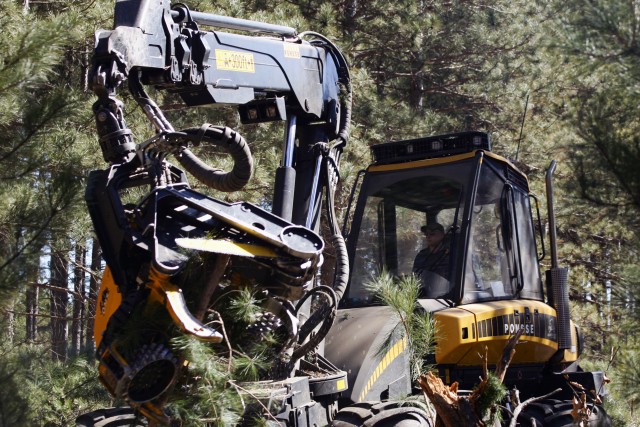FORT McCOY, Wis. -- Logging operations at Fort McCoy are planned and managed to benefit both the installation and neighboring communities, said Jim Kerkman.
Kerkman, forester for the Fort McCoy Directorate of Public Works (DPW), said logging operations provide a source of marketable wood for lumber, firewood and paper, as well as help improve the health of the installation's trees and increase the safety of people both on and off the installation. Management techniques include removing older, dying, dead or fallen trees or thinning out trees for health or safety reasons.
Trees have varying life spans and need to be managed to ensure they remain healthy to support the installation's environmental system and support or improve training opportunities, he said.
Kerkman said Forestry works hand-in-hand with the Fort McCoy Directorate of Plans, Training, Mobilization and Security (DPTMS) Land Rehabilitation and Maintenance (LRAM) program to coordinate the work necessary to ensure the logging operations are a success. LRAM is aligned under the DPTMS Integrated Training Area Management program.
Brooks Lundeen, LRAM coordinator, said LRAM also works in coordination with Forestry to benefit training by removing trees and woody debris that isn't marketable.
The LRAM crew uses heavy-duty forestry mowers to shred the vegetation, which allows access to areas and improves them for training purposes.
"We help ensure there is long-term maneuver access to the training areas for Soldiers, Range personnel and all others, if need be," Lundeen said. "We also help maintain cover and concealment in these areas by preserving selected trees during the shredding process that may be harvestable in the future."
In addition to shredding, the LRAM team performs trail- and training-area maintenance, reconfigures sites to increase training potential, and repairs maneuver damage, including native grass seeding and erosion-control projects to meet Army guidelines or standards for sustainability, he said.
Kerkman said too many trees in an area can hinder tree growth. Selective removal of trees allows for growth opportunities and better health for the remaining trees, he said.
In some instances, it's a case of safety. Kerkman said, for example, a high tree density near a range may pose a fire risk for neighboring properties if the vegetation catches fire during training. Removing some of the trees can create a bigger buffer zone, he said. Likewise, Kerkman said fires in trees or vegetation on or near a range can delay or prevent necessary military training so it is important to control vegetation on or around ranges. Logging operations also reduce trees along roadways, which can help improve visibility and safety for motorists.
Revenue from the timber sales goes into an Armywide forestry account and is used to fund forestry projects on Fort McCoy.
For more information about logging operations at Fort McCoy, call Forestry at 608-388-2102.




Social Sharing